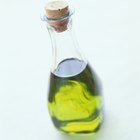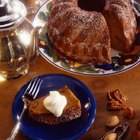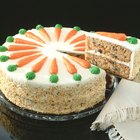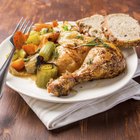
Jeffrey Hamilton/Digital Vision/Getty Images
Greasing pans when cooking and baking prevents food from sticking to the pan. Canola oil is one of the many types of shortenings and oils you can use to grease a pan. To avoid over-browning, use an oil with a smoking point appropriate for the baking temperature. Most cooking oils are available in spray cans, or you can make your own atomizer with a bottle equipped with a spray nozzle.
Canola Oil
Made from a rapeseed especially grown to make cooking oil, canola oil has a medium-high smoking point of 400 degrees Fahrenheit or lower, so you can use it to grease cake, cookie, muffin and bread pans, as well as casserole dishes and baking sheets that are baked at or below 400 F.
Corn Oil
Pans greased with corn oil can withstand temperatures up to 450 F without burning. It's particularly good for greasing pans for savory dishes because it imparts a slight taste of corn during baking.
Vegetable Oil
Generally a mixture of corn, sunflower and canola oil, vegetable oil has a high smoking point of around 495 F. It's best for greasing pans used in very hot ovens for searing, pan roasting or broiling.
Olive Oil
Although olive oil is a smart choice for cooking and baking, don't use it to grease pans. Depending on the level of purification, olive oil has a smoking point between 325 and 375 F, which makes it inappropriate for some baking tasks. Olive oil can also add flavors to sweet baked goods that clash with other ingredients.
Shortening Alternatives
Solid shortenings are also good for greasing pans and easy to apply with a paper towel. Solid vegetable shortening adds little flavor to baked food and has a smoking point of about 360 F. Butter adds rich flavor when used to grease pans but a relatively low smoking point of 250 F to 300 F. Solid margarine has a smoking point similar to butter, and soft margarine smokes at around 300 F, which varies slightly according to the types of oil used in the margarine. Lard creates a good crust on baked goods and has a smoking point between 280 F and 400 F, depending on its quality and the processing method.
Related Articles

How Much Melted Shortening Do I Use in ...

Roshco Silicone Bakeware Instructions

How to Cook With Stainless-Steel Frying ...

Can You Use Olive Oil in a Bread Mix?

Does Canola Oil Taste the Same as ...

What is Rapeseed Oil?

How to Convert a Pan Cake to a Bundt ...

Substitutes for Groundnut Oil in Cooking

What Kind of Oil Should I Use to ...

What Is Expeller Pressed Canola Oil?

What Can Be Used to Substitute for ...
Substitutes for Olive Oil in Cooking

Alternatives to a Deep Fryer

Is Butter or Shortening Better for Soft ...

Glass Pie Pan Baking Tips

What Are Good Substitutes for Vegetable ...

Are Nickel Lined Pans Safe?

How to Refinish Cast Iron Cornstick Pans

The Best Way to Cook Breaded Chicken ...
How to Make Homemade Brownies With ...
References
Writer Bio
Cassie Damewood has been a writer and editor since 1985. She writes about food and cooking for various websites, including My Great Recipes, and serves as the copy editor for "Food Loves Beer" magazine. Damewood completed a Bachelor of Arts in English with an emphasis in creative writing at Miami University.
Photo Credits
Jeffrey Hamilton/Digital Vision/Getty Images